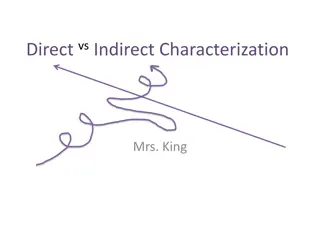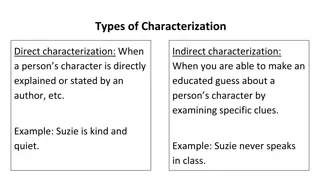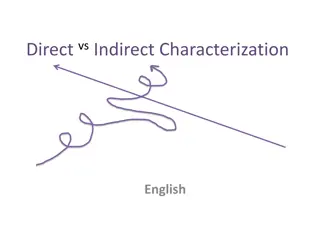Understanding Characterization in Literature
Characterization in literature involves the process through which authors reveal the personalities of characters. There are two main types: direct and indirect. Direct characterization involves the author explicitly telling the audience about the character's traits, while indirect characterization requires readers to infer personality traits based on actions, behaviors, opinions of other characters, and dialogue/thoughts. Examples and methods of both types are discussed to help understand how authors develop characters in stories.
Download Presentation

Please find below an Image/Link to download the presentation.
The content on the website is provided AS IS for your information and personal use only. It may not be sold, licensed, or shared on other websites without obtaining consent from the author. Download presentation by click this link. If you encounter any issues during the download, it is possible that the publisher has removed the file from their server.
E N D
Presentation Transcript
What is Characterization? Characterization is the process by which the author reveals the personality of characters. There are two types of characterization: Direct Indirect
Direct Characterization Direct characterization is when the author TELLS the audience what the personality of the character is. Examples: Mr. Kraler is a Dutchman, dependable, kindly. The Diary of Anne Frank Terry Erickson was a tall boy, 13, starting to fill out with muscle, but still a little awkward. He was on the edge of being a good athlete, which meant a lot to him. He felt it coming too slowly, though, and that bothered him. Stop the Sun
More about Direct Characterization Anne is thirteen, quick in her movements, interested in everything, mercurial in her emotions. The Diary of Anne Frank The author is directly telling us what Anne is like. Direct characterization does not require the reader to make inferences or draw conclusions.
More about Indirect Characterization Indirect characterization is when the author SHOWS things that reveal the personality of the character. This requires the reader to make inferences based upon clues. There are 4 different methods of indirect characterization: A. Appearance/Actions (Body language, dress, etc.) B. Behavior (What does the character do?) C. Character s Opinions (Other character s opinions) D. Dialogue & Thoughts (What does the character say & think?)
More about Indirect Characterization Appearance/Actions: What does the character look like? How does the character dress? What kind of body language is described? Example: Several girls tried to talk with Kayla at lunch, but she wouldn t make eye contact and hid behind her hair. You can infer that Kayla is painfully shy and uncomfortable in social situations.
More about Indirect Characterization Behavior: What does the character do? How does the character behave? Example: As Peter passes, Anne puts out her foot tripping him. The Diary of Anne Frank The kid (Red Chief) was in the street throwing rocks at a kitten. The Ransom of Red Chief
More about Indirect Characterization Character s Opinions: What is revealed through the character s effect on other people? How do other characters feel or behave in reaction to the character? Examples: Miss Kinnian told that I was her bestist pupil in the adult nite scool because I tried the hardist and I reely wanted to lern. Flowers for Algernon Dr. Nemur said that Dr. Strauss was nothing but an opportunist (someone who takes advantage of any opportunity regardless of consequences) Flowers for Algernon
Even MORE about Indirect Characterization Dialogue/Thoughts: What does the character say and/or think? Examples of dialogue: I m sort of a lone wolf. The Diary of Anne Frank I ve just been thinking-John and Lucy Combes. Must have been a couple of kids I ran over near Cambridge. Beastly bad luck. I had my license suspended for a year. Beastly nuisance. And Then There Were None
The Difference Remember, the difference between direct characterization and indirect characterization is TELLING v. SHOWING! Indirect characterizations are like clues about the characters. There is no mystery with direct characterization because the author gives us the information we need to know!























